Mullins L.J. Management and organisational behaviour, Seventh edition
Подождите немного. Документ загружается.


not allow sufficient opportunity for personal development, then the manager should
attempt to provide greater opportunities for the subordinate to satisfy existence and
relatedness needs.
Herzberg’s original study consisted of interviews with 203 accountants and engineers,
chosen because of their growing importance in the business world, from different
industries in the Pittsburgh area of America.
33
He used the critical incident method.
Subjects were asked to relate times when they felt exceptionally good or exceptionally
bad about their present job or any previous job. They were asked to give reasons and a
description of the sequence of events giving rise to that feeling. Responses to the inter-
views were generally consistent, and revealed that there were two different sets of
factors affecting motivation and work. This led to the two-factor theory of motiva-
tion and job satisfaction.
One set of factors are those which, if absent, cause dissatisfaction. These factors are
related to job context, they are concerned with job environment and extrinsic to the
job itself. These factors are the ‘hygiene’ or ‘maintenance’ factors (’hygiene’ being used as
analogous to the medical term meaning preventive and environmental). They serve to
prevent dissatisfaction. The other set of factors are those which, if present, serve to
motivate the individual to superior effort and performance. These factors are related to
job content of the work itself. They are the ‘motivators’ or growth factors. The strength of
these factors will affect feelings of satisfaction or no satisfaction, but not dissatisfaction
(see Figure 12.6).
The hygiene factors can be related roughly to Maslow’s lower-level needs and the
motivators to Maslow’s higher-level needs (Table 12.2) Proper attention to the hygiene
factors will tend to prevent dissatisfaction, but does not by itself create a positive atti-
tude or motivation to work. It brings motivation up to a zero state. The opposite of
dissatisfaction is not satisfaction but, simply, no dissatisfaction. To motivate work-
ers to give of their best the manager must give proper attention to the motivators or
growth factors. Herzberg emphasises that hygiene factors are not a ‘second class citizen
system’. They are as important as the motivators, but for different reasons. Hygiene
factors are necessary to avoid unpleasantness at work and to deny unfair treatment.
‘Management should never deny people proper treatment at work.’ The motivators
relate to what people are allowed to do and the quality of human experience at work.
They are the variables which actually motivate people.
Evaluation of Herzberg’s work
The motivation–hygiene theory has extended Maslow’s hierarchy of need theory and is
more directly applicable to the work situation. Herzberg’s theory suggests that if man-
agement is to provide positive motivation then attention must be given not only to
hygiene factors, but also to the motivating factors. The work of Herzberg indicates that
it is more likely good performance leads to job satisfaction rather than the reverse.
Herzberg’s theory is, however, a source of frequent debate. There have been many
other studies to test the theory. The conclusions have been mixed. Some studies pro-
vide support for the theory.
34
However, it has also been attacked by a number of
writers. For example, Vroom claims that the two-factor theory was only one of many
conclusions that could be drawn from the research.
35
King suggests that there are at least five different theoretical interpretations of
Herzberg’s model which have been tested in different studies.
36
Each interpretation
CHAPTER 12 WORK MOTIVATION AND REWARDS
485
HERZBERG’S TWO-FACTOR THEORY
Hygiene and
motivating
factors
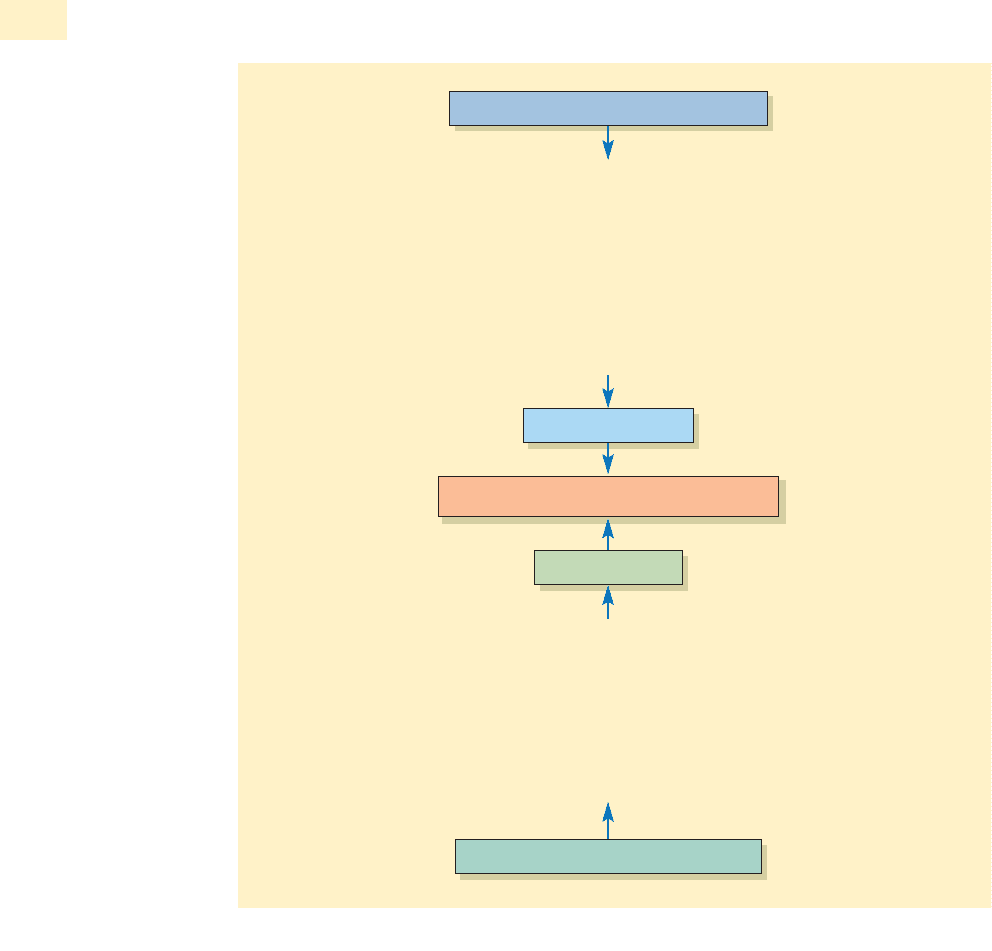
places a different slant on the model. This suggests doubts about the clarity of state-
ment of the theory.
There are two common general criticisms of Herzberg’s theory. One criticism is that the
theory has only limited application to ‘manual’ workers. The other criticism is that the
theory is ‘methodologically bound’.
It is often claimed that the theory applies least to people with largely unskilled jobs
or whose work is uninteresting, repetitive and monotonous, and limited in scope. Yet
these are the people who often present management with the biggest problem of moti-
vation. Some workers do not seem greatly interested in the job content of their work,
or with the motivators or growth factors.
A second, general criticism concerns methodology. It is claimed that the critical inci-
dent method, and the description of events giving rise to good or bad feelings,
influences the results. People are more likely to attribute satisfying incidents at work,
486
PART 4 THE INDIVIDUAL
Salary
Job security
Working conditions
Level and quality of supervision
Company policy and administration
Interpersonal relations
Sense of achievement
Recognition
Responsibility
Nature of the work
Personal growth and advancement
HYGIENE OR MAINTENANCE FACTORS
THE DISSATISFIERS
MOTIVATION AND JOB SATISFACTION
THE SATISFIERS
MOTIVATORS OR GROWTH FACTORS
Figure 12.6 Representation of Herzberg’s two-factor theory
Two general
criticisms

that is the motivators, as a favourable reflection on their own performance. The dissat-
isfying incidents, that is the hygiene factors, are more likely to be attributed to external
influences, and the efforts of other people. Descriptions from the respondents had to
be interpreted by the interviewers. This gives rise to the difficulty of distinguishing
clearly between the different dimensions, and to the risk of possible interviewer bias.
More recent studies still yield mixed conclusions about the practical relevance of the
two-factor theory. For example, from an examination of the relevance to industrial
salespeople, Shipley and Kiely generally found against Herzberg. Their results:
seriously challenge the worth of Herzberg’s theory to industrial sales managers. Its application
by them would result in a less than wholly motivated and at least partially dissatisfied team of
salespeople.
37
Despite such criticisms, there is still evidence of support for the continuing relevance
of the theory. For example, although based on a small sample of engineers within a
single company in Canada, Phillipchuk attempted to replicate Herzberg’s study in
today’s environment. He concludes that Herzberg’s methods still yield useful results.
Respondents did not offer any new event factors from the original study although
some old factors were absent. Salary and working conditions were not mentioned as a
satisfier or a dissatisfier, and advancement as a satisfier did not appear. The top demo-
tivator was company policy and the top motivator was achievement.
38
And according to Crainer and Dearlove:
Herzberg’s work has had a considerable effect on the rewards and remuneration packages
offered by corporations. Increasingly, there is a trend towards ‘cafeteria’ benefits in which
people can choose from a range of options. In effect, they can select the elements they recog-
nise as providing their own motivation to work. Similarly, the current emphasis on
self-development, career management and self-managed learning can be seen as having
evolved from Herzberg’s insights.
39
Whatever the validity of the two-factor theory much of the criticism is with the value
of hindsight, and Herzberg did at least attempt an empirical approach to the study of
motivation at work. Furthermore, his work has drawn attention to the importance of
job design in order to bring about job enrichment, self-development and self-managed
learning. Herzberg has emphasised the importance of the ‘quality of work life’. He
advocates the restructuring of jobs to give greater emphasis to the motivating factors at
work, to make jobs more interesting and to satisfy higher level needs. Job design and
job enrichment are discussed in Chapter 18.
McClelland’s work originated from investigations into the relationship between hunger
needs and the extent to which imagery of food dominated thought processes. From
subsequent research McClelland identified four main arousal-based, and socially devel-
oped, motives:
■ the Achievement motive;
■ the Power motive;
■ the Affiliative motive; and
■ the Avoidance motive.
40
The first three motives correspond, roughly, to Maslow’s self-actualisation, esteem and
love needs. The relative intensity of these motives varies between individuals. It also
tends to vary between different occupations. Managers appear to be higher in achieve-
CHAPTER 12 WORK MOTIVATION AND REWARDS
487
Continuing
relevance of
the theory?
MCCLELLAND’S ACHIEVEMENT MOTIVATION THEORY

ment motivation than in affiliation motivation. McClelland saw the achievement need
(n-Ach) as the most critical for the country’s economic growth and success. The need to
achieve is linked to entrepreneurial spirit and the development of available resources.
Research studies by McClelland use a series of projective ‘tests’ – Thematic
Apperception Test (TAT) to gauge an individual’s motivation. For example, individuals
are shown a number of pictures in which some activity is depicted. Respondents are
asked to look briefly (10–15 seconds) at the pictures, and then to describe what they
think is happening, what the people in the picture are thinking and what events have
led to the situation depicted.
41
An example of a picture used in a projective test is
given in Assignment 2 at the end of this chapter. The descriptions are used as a basis
for analysing the strength of the individual’s motives.
People with high achievement needs
Despite the apparent subjective nature of the judgements research studies tend to sup-
port the validity of TAT as an indicator of the need for achievement.
42
McClelland has,
over years of empirical research, identified four characteristics of people with a strong
achievement need (n-Ach): a preference for moderate task difficulty; personal responsi-
bility for performance; the need for feedback; and innovativeness.
■ They prefer moderate task difficulty and goals as an achievement incentive. This
provides the best opportunity of proving they can do better. If the task is too diffi-
cult or too risky, it would reduce the chances of success and of gaining need
satisfaction. If the course of action is too easy or too safe, there is little challenge in
accomplishing the task and little satisfaction from success.
■ They prefer personal responsibility for performance. They like to attain success
through the focus of their own abilities and efforts rather than by teamwork or
chance factors outside their control. Personal satisfaction is derived from the accom-
plishment of the task, and recognition need not come from other people.
■ They have the need for clear and unambiguous feedback on how well they are
performing. A knowledge of results within a reasonable time is necessary for self-
evaluation. Feedback enables them to determine success or failure in the
accomplishment of their goals, and to derive satisfaction from their activities.
■ They are more innovative. As they always seek moderately challenging tasks they
tend always to be moving on to something a little more challenging. In seeking
short cuts they are more likely to cheat. There is a constant search for variety and for
information to find new ways of doing things. They are more restless and avoid rou-
tine, and also tend to travel more.
The extent of achievement motivation varies between individuals. Some people think
about achievement a lot more than others. Some people rate very highly in achieve-
ment motivation. They are challenged by opportunities and work hard to achieve a
goal. Other people rate very low in achievement motivation. They do not care much
and have little urge to achieve. For people with a high achievement motivation,
money is not an incentive but may serve as a means of giving feedback on perform-
ance. High achievers seem unlikely to remain long with an organisation that does not
pay them well for good performance. Money may seem to be important to high
achievers, but they value it more as symbolising successful task performance and goal
achievement. For people with low achievement motivation money may serve more as
a direct incentive for performance.
McClelland’s research has attempted to understand the characteristics of high achiev-
ers. He suggests that n-Ach is not hereditary but results from environmental influences,
488
PART 4 THE INDIVIDUAL
Use of
projective
tests
Extent of
achievement
motivation

and he has investigated the possibility of training people to develop a greater motivation
to achieve.
43
McClelland suggests four steps in attempting to develop achievement drive:
■ Striving to attain feedback on performance. Reinforcement of success serves to
strengthen the desire to attain higher performance.
■ Developing models of achievement by seeking to emulate people who have per-
formed well.
■ Attempting to modify their self-image and to see themselves as needing challenges
and success.
■ Controlling day-dreaming and thinking about themselves in more positive terms.
McClelland was concerned with economic growth in underdeveloped countries. He
has designed training programmes intended to increase the achievement motivation
and entrepreneurial activity of managers.
McClelland has also suggested that as effective managers need to be successful leaders
and to influence other people, they should possess a high need for power.
44
However,
the effective manager also scores high on inhibition. Power is directed more towards
the organisation and concern for group goals, and is exercised on behalf of other
people. This is ‘socialised’ power. It is distinguished from ‘personalised’ power which is
characterised by satisfaction from exercising dominance over other people, and per-
sonal aggrandisement.
Process theories, or extrinsic theories, attempt to identify the relationships among the
dynamic variables which make up motivation and the actions required to influence
behaviour and actions. They provide a further contribution to our understanding of the
complex nature of work motivation. Many of the process theories cannot be linked to a
single writer, but major approaches and leading writers under this heading include:
■ Expectancy-based models – Vroom, and Porter and Lawler
■ Equity theory – Adams
■ Goal theory – Locke
■ Attribution theory – Heider, and Kelley (this was discussed in Chapter 11).
The underlying basis of expectancy theory is that people are influenced by the
expected results of their actions. Motivation is a function of the relationship between:
1 effort expended and perceived level of performance; and
2the expectation that rewards (desired outcomes) will be related to performance.
There must also be
3the expectation that rewards (desired outcomes) are available.
These relationships determine the strength of the ‘motivational link’. (See Figure 12.7.)
Performance therefore depends upon the perceived expectation regarding effort
expended and achieving the desired outcome. For example, the desire for promotion
will result in high performance only if the person believes there is a strong expectation
that this will lead to promotion. If, however, the person believes promotion to be
based solely on age and length of service, there is no motivation to achieve high per-
formance. A person’s behaviour reflects a conscious choice between the comparative
evaluation of alternative behaviours. The choice of behaviour is based on the
expectancy of the most favourable consequences.
CHAPTER 12 WORK MOTIVATION AND REWARDS
489
The need
for power
PROCESS THEORIES OF MOTIVATION
Expectancy
theories of
motivation
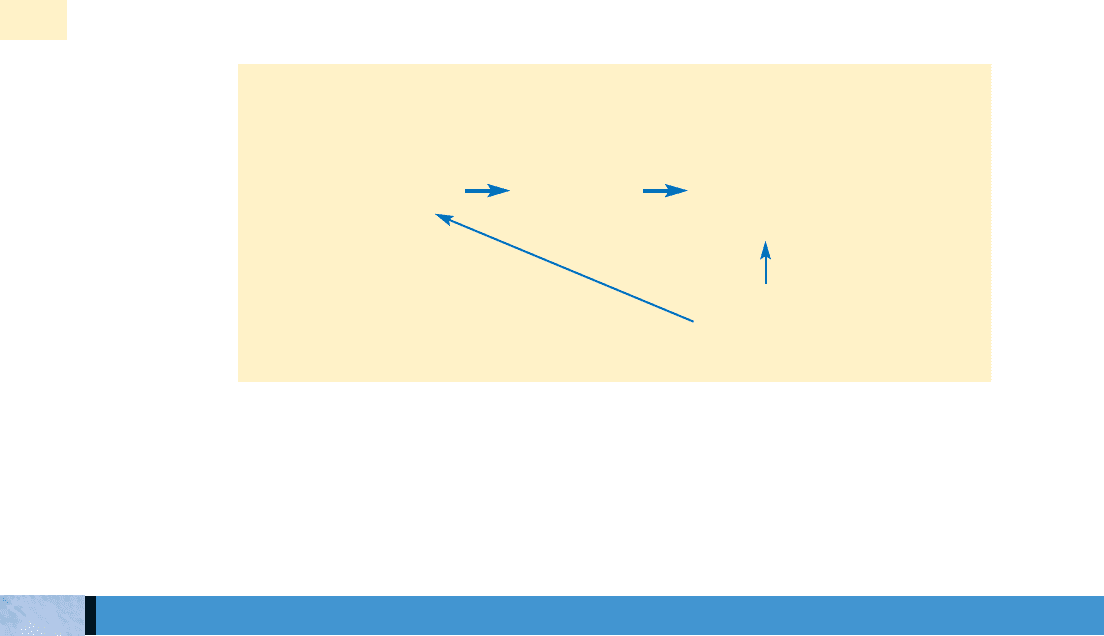
Expectancy theory is a generic theory of motivation and cannot be linked to a single
individual writer. There are a number of different versions and some of the models are
rather complex. More recent approaches to expectancy theory have been associated
with the work of Vroom and of Porter and Lawler.
Vroom was the first person to propose an expectancy theory aimed specifically at work
motivation.
45
His model is based on three key variables: valence, instrumentality and
expectancy (VIE theory or expectancy/valence theory). The theory is founded on the
idea that people prefer certain outcomes from their behaviour over others. They antici-
pate feelings of satisfaction should the preferred outcome be achieved.
The feeling about specific outcomes is termed valence. This is the attractiveness of,
or preference for, a particular outcome to the individual. Vroom distinguishes
valence from value. A person may desire an object but then gain little satisfaction from
obtaining it. Alternatively, a person may strive to avoid an object but find, sub-
sequently, that it provides satisfaction. Valence is the anticipated satisfaction from
an outcome. This may differ substantially from value, which is the actual satisfaction
provided by an outcome.
The valence of certain outcomes may be derived in their own right, but more usu-
ally they are derived from the other outcomes to which they are expected to lead. An
obvious example is money. Some people may see money as having an intrinsic worth
and derive satisfaction from the actual accumulation of wealth. Most people, however,
see money in terms of the many satisfying outcomes to which it can lead.
The valence of outcomes derives, therefore, from their instrumentality. This leads to a
distinction between first-level outcomes and second-level outcomes.
■ The first-level outcomes are performance-related. They refer to the quantity of
output or to the comparative level of performance. Some people may seek to per-
form well ‘for its own sake’ and without thought to expected consequences of their
actions. Usually, however, performance outcomes acquire valence because of the
expectation that they will lead to other outcomes as an anticipated source of satis-
faction – second-level outcomes.
490
PART 4 THE INDIVIDUAL
and
MOTIVATION – a function of the perceived relationship between
Effort
expended
Effective level
of performance
Rewards (desired
outcomes) related
to performance
Availability of
rewards (desired
outcomes)
(2)(1)
(3)
Figure 12.7 Expectancy theory: the motivational link
VROOM’S EXPECTANCY THEORY
Valence
Instrumentality
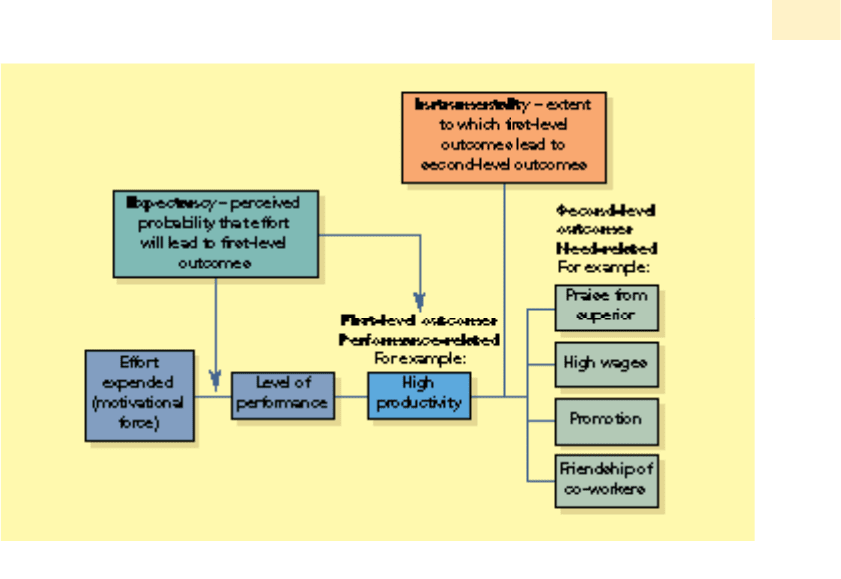
■ The second-level outcomes are need-related. They are derived through achieve-
ment of first-level outcomes – that is, through achieving high performance. Many
need-related outcomes are dependent upon actual performance rather than effort
expended. People generally receive rewards for what they have achieved, rather than
for effort alone or through trying hard.
On the basis of Vroom’s expectancy theory it is possible to depict a general model of
behaviour. (See Figure 12.8.)
When a person chooses between alternative behaviours which have uncertain out-
comes, the choice is affected not only by the preference for a particular outcome, but
also by the probability that such an outcome will be achieved. People develop a per-
ception of the degree of probability that the choice of a particular action will actually
lead to the desired outcome. This is expectancy. It is the relationship between a
chosen course of action and its predicted outcome. Expectancy relates effort expended
to the achievement of first-level outcomes. Its value ranges between 0, indicating zero
probability that an action will be followed by the outcome, and 1, indicating certainty
that an action will result in the outcome.
Motivational force
The combination of valence and expectancy determines the person’s motivation for a
given form of behaviour. This is the motivational force. The force of an action is unaf-
fected by outcomes which have no valence, or by outcomes that are regarded as
unlikely to result from a course of action. Expressed as an equation, motivation (M) is
the sum of the products of the valences of all outcomes (V), times the strength of
expectancies that action will result in achieving these outcomes (E). Therefore, if
either, or both, valence or expectancy is zero, then motivation is zero. The choice
between alternative behaviours is indicated by the highest attractiveness score.
M =
∑
n
E · V
CHAPTER 12 WORK MOTIVATION AND REWARDS
491
Figure 12.8 Basic model of expectancy theory
Expectancy
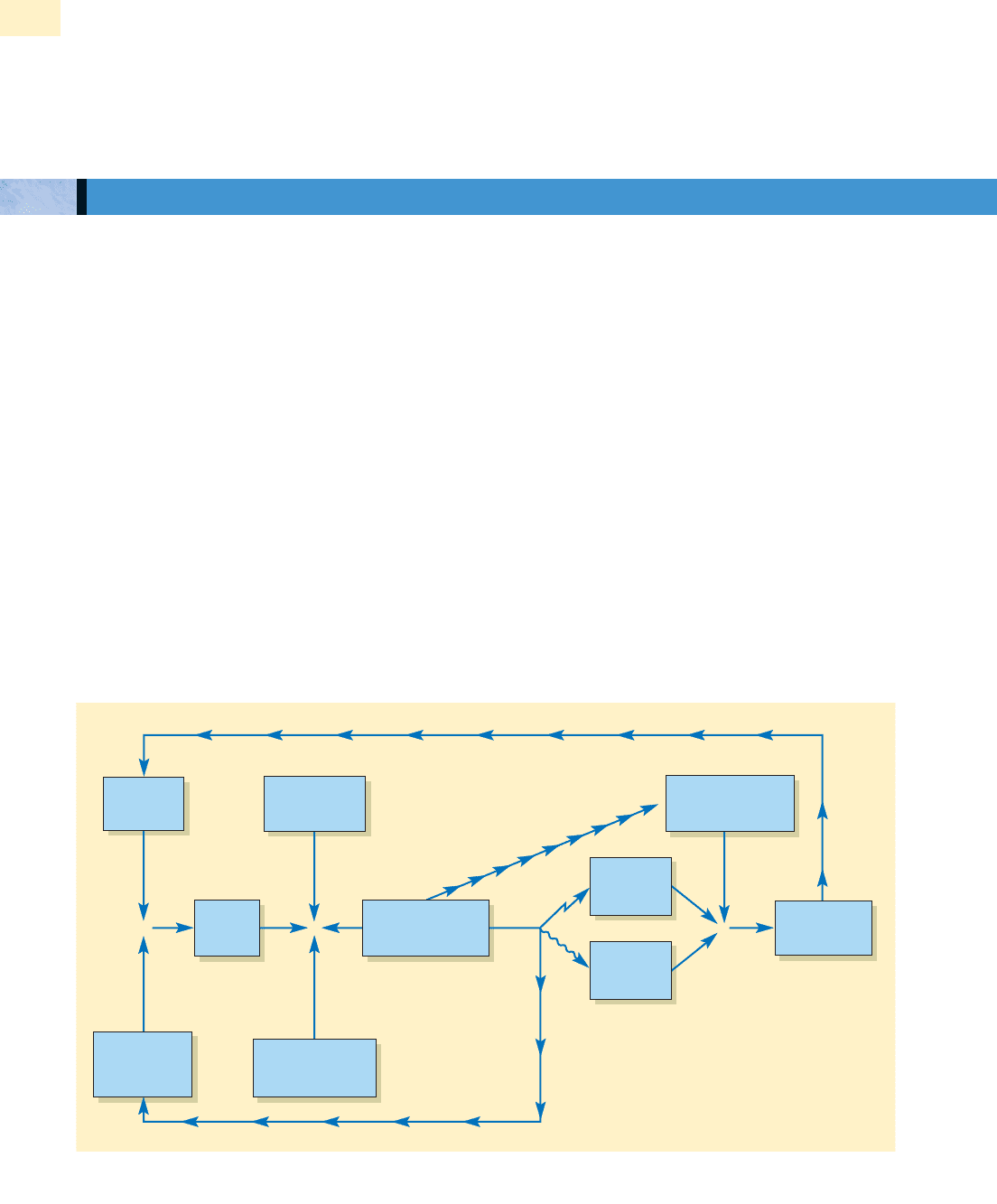
There are likely to be a number of different outcomes expected for a given action.
Therefore, the measure of E · V is summed across the total number of possible out-
comes to arrive at a single figure indicating the attractiveness for the contemplated
choice of behaviour.
Vroom’s expectancy/valence theory has been developed by Porter and Lawler.
46
Their
model goes beyond motivational force and considers performance as a whole. They
point out that effort expended (motivational force) does not lead directly to per-
formance. It is mediated by individual abilities and traits, and by the person’s role
perceptions. They also introduce rewards as an intervening variable. Porter and Lawler
see motivation, satisfaction and performance as separate variables, and attempt to
explain the complex relationships among them. Their model recognises that job satis-
faction is more dependent upon performance, than performance is upon satisfaction.
These relationships are expressed diagrammatically (Figure 12.9) rather than mathe-
matically. In contrast to the human relations approach which tended to assume that
job satisfaction leads to improved performance, Porter and Lawler suggest that satisfac-
tion is an effect rather than a cause of performance. It is performance that leads to
job satisfaction.
■ Value of reward (Box 1) is similar to valence in Vroom’s model. People desire vari-
ous outcomes (rewards) which they hope to achieve from work. The value placed on
a reward depends on the strength of its desirability.
■ Perceived effort–reward probability (Box 2) is similar to expectancy. It refers to a
person’s expectation that certain outcomes (rewards) are dependent upon a given
amount of effort.
492
PART 4 THE INDIVIDUAL
THE PORTER AND LAWLER EXPECTANCY MODEL
Explanation of
relationships
Value of
reward
Abilities and
traits
Performance
(accomplishment)
Effort
Perceived
effort–reward
probability
Role perceptions
Intrinsic
rewards
Extrinsic
rewards
Perceived
equitable rewards
Satisfaction
9
7A
7B
8
6
5
4
1
3
2
Figure 12.9 The Porter and Lawler motivation model
(Source: Porter, I. W. and Lawler, E. E. Managerial Attitudes and Performance. Copyright © Richard D. Irwin Inc. (1968) p. 165.)

■ Effort (Box 3) is how hard the person tries, the amount of energy a person exerts on
a given activity. It does not relate to how successful a person is in carrying out an
activity. The amount of energy exerted is dependent upon the interaction of the
input variables of value of reward, and perception of the effort–reward relationship.
■ Abilities and traits (Box 4). Porter and Lawler suggest that effort does not lead
directly to performance, but is influenced by individual characteristics. Factors such
as intelligence, skills, knowledge, training and personality affect the ability to per-
form a given activity.
■ Role perceptions (Box 5) refer to the way in which individuals view their work and
the role they should adopt. This influences the type of effort exerted. Role percep-
tions will influence the direction and level of action which is believed to be
necessary for effective performance.
■ Performance (Box 6) depends not only on the amount of effort exerted but also on
the intervening influences of the person’s abilities and traits, and their role percep-
tions. If the person lacks the right ability or personality, or has an inaccurate role
perception of what is required, then the exertion of a large amount of energy may
still result in a low level of performance, or task accomplishment.
■ Rewards (Boxes 7A and 7B) are desirable outcomes. Intrinsic rewards derive from the
individuals themselves and include a sense of achievement, a feeling of responsibility
and recognition (for example Herzberg’s motivators). Extrinsic rewards derive from
the organisation and the actions of others, and include salary, working conditions
and supervision (for example Herzberg’s hygiene factors). The relationship between
performance and intrinsic rewards is shown as a jagged line. This is because the
extent of the relationship depends upon the nature of the job. If the design of the job
permits variety and challenge, so that people feel able to reward themselves for good
performance, there is a direct relationship. Where job design does not involve variety
and challenge, there is no direct relationship between good performance and intrin-
sic rewards. The wavy line between performance and extrinsic rewards indicates that
such rewards do not often provide a direct link to performance.
■ Perceived equitable rewards (Box 8). This is the level of rewards people feel they
should fairly receive for a given standard of performance. Most people have
an implicit perception about the level of rewards they should receive commen-
surate with the requirements and demands of the job, and the contribution
expected of them. Self-rating of performance links directly with the perceived equit-
able reward variable. Higher levels of self-rated performance are associated with
higher levels of expected equitable rewards. The heavily arrowed line indicates a
relationship from the self-rated part of performance to perceived equitable rewards.
■ Satisfaction (Box 9). This is not the same as motivation. It is an attitude, an individ-
ual’s internal state. Satisfaction is determined by both actual rewards received, and
perceived level of rewards from the organisation for a given standard of per-
formance. If perceived equitable rewards are greater than actual rewards received,
the person experiences dissatisfaction. The experience of satisfaction derives from
actual rewards which meet or exceed the perceived equitable rewards.
Porter and Lawler conducted an investigation of their own model. This study involved
563 questionnaires from managers in seven different industrial and government organ-
isations. The main focus of the study was on pay as an outcome. The questionnaires
obtained measures from the managers for a number of variables such as value of
reward, effort–reward probability, role perceptions, perceived equitable rewards, and
satisfaction. Information on the managers’ effort and performance was obtained from
their superiors. The results indicated that where pay is concerned, value of reward and
perceived effort–reward probability do combine to influence effort.
Those managers who believed pay to be closely related to performance outcome
received a higher effort and performance rating from their superiors. Those managers
CHAPTER 12 WORK MOTIVATION AND REWARDS
493
Investigation
of the model
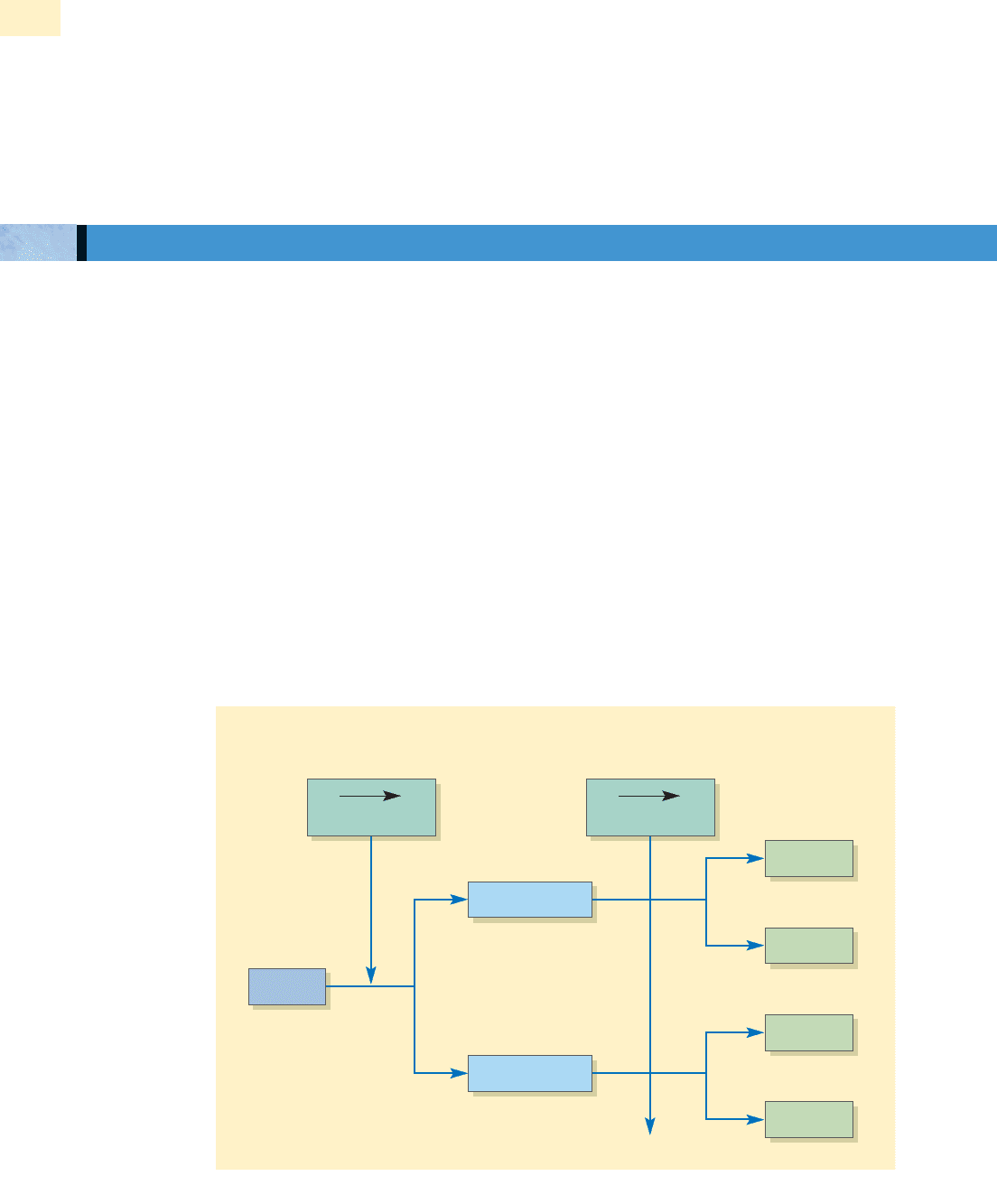
who perceived little relationship between pay and performance had lower ratings for
effort and performance. The study by Porter and Lawler also demonstrated the interac-
tion of effort and role perceptions to produce a high level of performance. Their study
suggested, also, that the relationship between performance and satisfaction with their
pay held good only for those managers whose performance was related directly to their
actual pay.
Following the original Porter and Lawler model, further work was undertaken by Lawler
(see Figure 12.10).
47
He suggests that in deciding on the attractiveness of alternative
behaviours, there are two types of expectancies to be considered: effort–performance
expectancies (E → P); and performance–outcome expectancies (P → O).
The first expectancy (E → P) is the person’s perception of the probability that a
given amount of effort will result in achieving an intended level of performance. It is
measured on a scale between 0 and 1. The closer the perceived relationship between
effort and performance, the higher the E → P expectancy score.
The second expectancy (P → O) is the person’s perception of the probability that a
given level of performance will actually lead to particular need-related outcomes. This
is measured also on a scale between 0 and 1. The closer the perceived relationship
between performance and outcome, the higher the P → O expectancy score.
The multiplicative combination of the two types of expectancies, E → P and the sum of
the products P → O, determines expectancy. The motivational force to perform (effort
expended) is determined by multiplying E → P and P → O by the strength of outcome
valence (V).
E (Effort) = (E → P) ×∑[(P → O) × V]
494
PART 4 THE INDIVIDUAL
LAWLER’S REVISED EXPECTANCY MODEL
Level of performance Need-related
outcomes
Performance
Effort
Outcome
E P
Expectancies
P O
Expectancies
Performance
Outcome
Outcome
Outcome
Figure 12.10 An illustration of the Lawler expectancy model
Motivational
force to
perform
